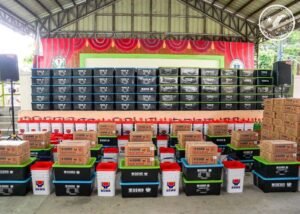Philippine Rice Research Institute (PhilRice) urged farmers to adopt the practice of “sabayang pagtatanim” or simultaneous planting.
This method focuses on the critical phase of crop establishment, aiming to increase yields and improve the overall health of rice crops.
Community Relations Office Science Research Specialist II Jonathan Cabral said the call comes as PhilRice recognizes the challenges faced by farmers in adhering to this recommended practice.

Factors such as limited water supply in certain localities and the desire to avoid peak seasons to secure higher rice prices often contribute to deviations from the prescribed rest period and simultaneous planting.
He explained that in simultaneous planting, farmers are advised to plant 14 days before or after the peak planting season, ensuring a collective effort in rice cultivation.
One of the primary benefits of this method is the effective prevention of the increase of pests and insects in rice fields.
“If farmers in an area plant simultaneously, their rice crops will almost be harvested at the same time. In this way, pests and insects have nothing to feed on, preventing them from multiplying,” Cabral noted.
Moreover, by allowing the fields to lie fallow for 30 days, farmers disrupt the life cycle of pests, reducing their numbers and mitigating potential damage to crops.
“Most pests have an average life cycle of 30 days. During the resting period, they have nowhere to stay, and the majority of them will die of hunger,” Cabral said.
This approach also reduces reliance on pesticides, minimizing the need for chemical interventions.
Another benefit of this practice is the efficient water usage from irrigation.
When farmers synchronize their planting schedules, they can collectively benefit from available irrigation water, avoiding conflicts and ensuring a fair distribution of resources.
Additionally, this practice benefits through the optimization of yields.
By limiting the proliferation of pests and adopting more effective water usage from irrigation, simultaneous planting optimizes yields and enhances crop quality in subsequent planting seasons.
To adhere to the simultaneous planting approach, PhilRice highly recommends that rice fields remain fallow for 30 days after harvest.
Aside from pest infestation control, Cabral explained that the habitats of diseases in rice are disrupted through the rest period. Also, organic materials such as hay or rice straw decompose thoroughly, serving as additional fertilizer.
In addition, PhilRice advises farmers to follow the planting season in the community to make the most of available water resources.
Cabral suggested that farmers should conduct simultaneous planting according to the water source in the community, barangay, or division.
Lastly, PhilRice emphasized the importance of community-wide collaboration in adopting this planting method.
“Simultaneous planting should be done as much as possible within the appropriate area. This means that in our community, we should all participate in this activity, and we encourage neighboring farmers to do the same so that everyone benefits from this process,” Cabral furthered.
For inquiries and additional guidance on rice planting, farmers may contact the PhilRice text center hotline at 0917-111-7423. (PIA 3)













